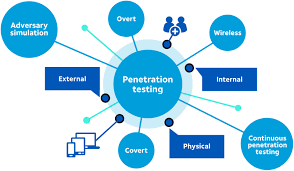Red Team Penetration Testing: Simulating Real-World Attacks
Red team
penetration testing is a highly effective method for assessing an
organization’s cybersecurity resilience by simulating real-world attacks. This
approach goes beyond traditional vulnerability assessments and focuses on
emulating the tactics, techniques, and procedures used by malicious actors. By
challenging security systems and processes, red team penetration testing helps
organizations identify weaknesses, improve defenses, and enhance overall
cybersecurity readiness. This proactive approach is essential in today’s
dynamic threat landscape.
The Role of Red
Team Penetration Testing in Cybersecurity
Red team penetration
testing plays a crucial role in evaluating an organization’s ability to
detect, respond to, and recover from sophisticated cyberattacks. Unlike
conventional testing methods that focus on identifying vulnerabilities, red
team exercises adopt an adversarial mindset to simulate real-world threats.
This allows organizations to gain insights into how attackers might exploit
weaknesses and assess the effectiveness of their detection and response
mechanisms. The results of these exercises inform strategic decisions, ensuring
a robust cybersecurity framework.
Simulating Advanced Persistent Threats with Red Teaming
Advanced
persistent threats (APTs) represent some of the most challenging risks for
organizations to address. Red team penetration testing is uniquely suited to
simulate these threats by mimicking the behavior of skilled attackers who aim
to remain undetected while gaining prolonged access to sensitive systems. By
emulating APT scenarios, red teams uncover gaps in security protocols and
provide actionable recommendations to strengthen defenses. This approach
ensures that organizations are prepared to counter even the most sophisticated
adversaries.
Enhancing Incident Response Capabilities through Red Team Testing
Incident
response is a critical component of any cybersecurity strategy, and red team
penetration testing provides valuable insights into its effectiveness. These
exercises test the ability of security teams to detect and respond to simulated
attacks, highlighting areas for improvement. By analyzing the results of red
team engagements, organizations can refine their incident response plans,
enhance collaboration among stakeholders, and implement best practices to
reduce the impact of potential breaches. This continuous improvement process is
vital for maintaining a resilient security posture.
Importance of Threat Intelligence in Red Team Exercises
Threat
intelligence is a foundational element of red team penetration testing. It
involves gathering and analyzing information about potential attackers, their
methods, and their targets. Red teams use this intelligence to design realistic
attack scenarios that closely mirror the tactics used by real-world
adversaries. By integrating threat intelligence into their exercises, red teams
ensure that their assessments are relevant, actionable, and aligned with the
organization’s risk profile. This approach maximizes the value of red team
testing and supports proactive risk management.
Identifying Weaknesses in Security Controls
One of the
primary objectives of red team penetration testing is to identify weaknesses in
an organization’s security controls. These exercises assess the effectiveness
of firewalls, intrusion detection systems, endpoint protection solutions, and
other security technologies. Red teams also evaluate non-technical factors,
such as employee awareness and adherence to security policies. By uncovering
vulnerabilities and gaps in defenses, red team testing provides organizations
with the insights needed to address weaknesses and enhance their security
posture.
Collaboration between Red Teams and Blue Teams
Red team
penetration testing often involves collaboration with blue teams, which are
responsible for defending the organization’s systems and networks. These
exercises, known as purple teaming, foster a culture of continuous learning and
improvement by enabling red and blue teams to share insights, strategies, and
techniques. This collaboration enhances the organization’s overall
cybersecurity capabilities, ensuring a more coordinated and effective response
to threats. Purple teaming also promotes a deeper understanding of the
attacker’s perspective, which is invaluable for improving defenses.
Real-World Scenarios for Comprehensive Testing
Red team
penetration testing uses real-world scenarios to provide a comprehensive
evaluation of an organization’s security posture. These scenarios include
phishing campaigns, social engineering attacks, and attempts to exploit
physical security weaknesses. By simulating a wide range of threats, red team
exercises uncover vulnerabilities that might otherwise go undetected. This
approach ensures that organizations are prepared to defend against diverse
attack vectors and maintain the integrity of their systems and data.
Benefits of Red Team Penetration Testing
The benefits
of red team penetration testing extend beyond identifying vulnerabilities.
These exercises enhance situational awareness, improve threat detection
capabilities, and foster a proactive approach to cybersecurity. Red team
testing also helps organizations meet regulatory requirements and demonstrate
their commitment to protecting sensitive data. By investing in red team
penetration testing, businesses can build resilience against cyberattacks,
safeguard their reputation, and maintain customer trust.
Aligning Red Team
Testing with Business Objectives
To maximize
the value of red team penetration testing, it is essential to align these
exercises with the organization’s business objectives. This involves defining
clear goals, prioritizing critical assets, and tailoring attack scenarios to
reflect the organization’s unique risk profile. By aligning red team testing
with strategic priorities, organizations can ensure that their cybersecurity
investments deliver measurable benefits and support long-term success. This
alignment also fosters a culture of security awareness and accountability
across the organization.
Future Trends in Red Team Penetration Testing
The field of
red team penetration testing is continuously evolving to address emerging
threats and technological advancements. Future trends include the integration
of artificial intelligence and machine learning to enhance attack simulations
and improve threat detection capabilities. Red teams are also exploring new
areas, such as IoT security, blockchain vulnerabilities, and quantum-resistant
cryptography. Staying ahead of these trends ensures that red team penetration
testing remains an effective tool for assessing and improving cybersecurity
resilience.
Conclusion: Strengthen Your Cybersecurity with Red Team Penetration Testing
In
conclusion, red team penetration
testing is an invaluable method for simulating real-world attacks and
assessing an organization’s cybersecurity readiness. By adopting an adversarial
perspective, red teams identify vulnerabilities, evaluate security controls,
and enhance incident response capabilities. These exercises provide actionable
insights that enable organizations to address weaknesses, improve defenses, and
build resilience against evolving threats. Investing in red team penetration
testing is a proactive step toward safeguarding critical assets, maintaining
compliance, and ensuring long-term success in an increasingly complex threat
landscape.

.jpeg)

.jpeg)
Comments
Post a Comment